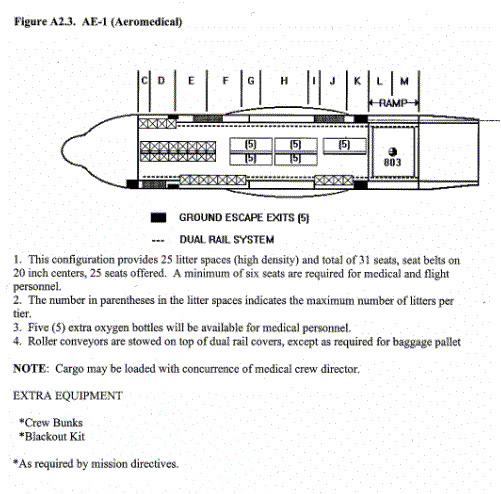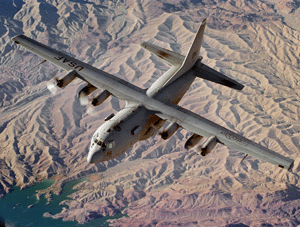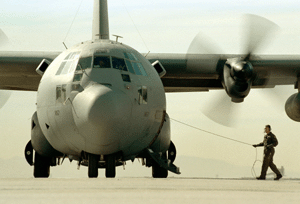C-130 Hercules* |
| This aircraft is a four-engine,
turbo-propeller driven aircraft with a pressurized, air-conditioned cabin
and a self-contained loading ramp.
The C-130 can land on and take off from short runways. It can also be used on landing strips such as those found in forward base operations. Its normal use is for tactical and assault airlift. The C-130 can also be used for strategic airlift missions, if required. The C-130 is a versatile aircraft, and can be configured in many ways. It is the internal configuration that determines its' medical airlift capability. Litters may be placed on the cargo floor and secured to the floor to avoid patient injury in the event of turbulence. Using center line stanchions and straps, litters may be stacked vertically along the length of the centerline, with web seats for ambulatory patients (and a few litter attachment points) toward the outside of the cabin. Maximum capacity is 70 litters with no ambulatory patients, 85 ambulatory patients with no litters, or a mixture. A variety of configurations are shown here. With Air Force C-130 MEDEVAC aircraft, a medical crew is typically provided, consisting of two flight nurses and three aeromedical evacuation technicians. Medical supplies vary but are usually tailored for the mission. Coast Guard C-130's are usually not configured for MEDEVAC, usually do not carry any crewmembers with medical training, and usually do not carry any medical supplies other than the first aid kits for the aircrew. Patients transported on these aircraft will need attendants to accompany them and to provide medical assistance in-flight, if needed. All necessary medical supplies should be sent with the patients. |
|


*From Operational Medicine 2001, Health Care in Military Settings, NAVMED P-5139, May 1, 2001, Bureau of Medicine and Surgery, Department of the Navy, 2300 E Street NW, Washington, D.C., 20372-5300
Contents · Introduction · Learning Objectives · Textbook · Lectures · Procedures · Final Exam · Library · Laboratory · Pharmacy · Imaging · Forms · Videos · Search · About the Author · Contact Us
Military Obstetrics & Gynecology
© 2005
Medical Education Division,
Brookside Associates, Ltd.
All rights reserved

